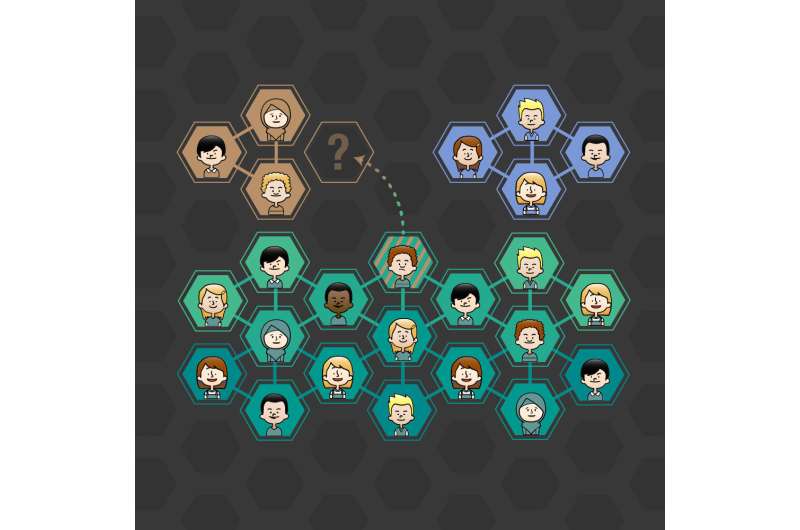This article has been reviewed according to Science X's editorial process and policies. Editors have highlighted the following attributes while ensuring the content's credibility:
fact-checked
peer-reviewed publication
trusted source
proofread
Predicting human group sizes with physics

Only by knowing the average number of friends each person has, scientists at Complexity Science Hub (CSH) were able to predict the group sizes of people in a computer game. For this purpose, they modeled the formation of social groups on an example from physics, namely the self-organization of particles with spin.
Sociologists have focused on how social groups are forming and the mechanism behind it for a long time. The urge to avoid stress, as well as homophily—the tendency of people to join groups with others who share similar features, traits, or opinions—have been observed in many different contexts.
"Although multiple models have been studied, little is known about how homophily and stress avoidance affect the formation of human groups, and in particular the size distribution of them—whether there are many small groups or few large ones, for example," explains Jan Korbel from CSH and first author of the study. By using two contemporary fields from physics, called self-assembly and spin glasses, scientists now shed new light on social group formation.
Cognitive challenges of people in groups
One defining feature of humans is that they organize themselves (often for specific purposes) in groups. "The difficulty here is that this needs coordination, which requires great effort," says Stefan Thurner from CSH. "When groups grow in size and internal conflicts arise, coordination can quickly reach and go beyond the cognitive limits of humans."
"So, there must be specific mechanisms that enable humans to organize in groups efficiently. And these should be explainable with a few very general human behavioral features, such as homophily and the tendency to avoid stress within groups," Thurner continues.
People behaving like particles with spin
Social groups typically emerge when people with similar opinions start interacting with each other. "In previous studies, we studied the self-assembly of nanoparticles in small thermodynamic systems, where they spontaneously form high-order structures without any external interventions. Then we realized: this is similar to what people do," Korbel recalls.
People interact with each other, and groups emerge very similar to particles that form colloids or polymers. Motivated by this, the research group developed a simple model for homophilic humans that is based on the mechanisms of self-organization of particles with spin.
Small information, big outcome
This model was able to predict the distribution of group size in the multiplayer online game Pardus. "Normally you would need to know the structure of the network and how it is designed," Korbel explains the results.
"Here we only need to know how many friends a player has on average." With this relatively small amount of information, the researchers were able to predict how many groups of a certain size would appear.
Key quantities in social systems
"Of course, people are more complicated than particles, but certain types of interactions between them are similar, in particular the number of possibilities that a set of people can form groups. This number is called entropy, and this is our starting point for mathematical modeling," says Thurner.
There were phases were people tended to form large groups, but others when this did not happen because opinions were too different. "Becoming member of a large group would have been too much social stress for them in this situation," Korbel states. Besides entropy, this social stress is the other key quantity here—a key quantity comparable to energy in physics. The more similar people in the group, the less social stress they might experience.
From magnets to opinions
From a physical point of view, this can be compared to spins: While in magnets all spins point in the same direction, in spin-glasses, which are alloys of metals and non-metals, they are disordered. Due to that complex structure, spins are in "stress", because they have to align with several other spins, and they cannot do it at the same time. "This is similar to a group with different opinions. You cannot align with all of them, and you probably get frustrated," Korbel draws the parallel.
"Intriguingly, very different systems can have the same expression for entropy. In our case, social individuals seem to have a similar entropy to structure-forming systems, such as certain spin glasses," says Thurner.
"Our new model can help to predict phenomena from sociology in connection with social networks and mass media that lead to social frustration and polarization," Korbel concludes. It also shows the potential of interdisciplinary research approaches, which are particularly valued at the Complexity Science Hub.
"The vision is to finally obtain more quantitative models that are testable on real data of how Homo sapiens organizes itself in groups, maybe the thing we do best as a species," Thurner adds.
The research is published in Physical Review Letters.
More information: Jan Korbel et al, Homophily-Based Social Group Formation in a Spin Glass Self-Assembly Framework, Physical Review Letters (2023). DOI: 10.1103/PhysRevLett.130.057401
Journal information: Physical Review Letters
Provided by Complexity Science Hub Vienna



















